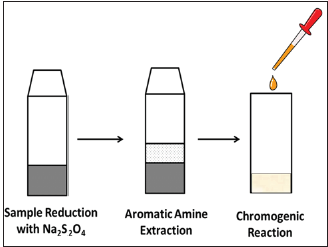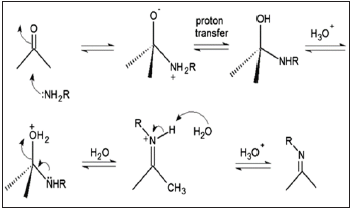- Submissions

Full Text
Novel Research in Sciences
Rapid Screening Methods to Detect Banned Azo Dyes in Textiles
Lili Sun1,2*, Zhenxing Lan1, Xia Liu1 and Fangfang Zuo1
1Guangzhou Inspection Testing and Certification Group Co., Ltd., China
2sup>Guangdong Key Laboratory of Environmental Pollution and Health, School of Environment, China
*Corresponding author:Lili Sun, Guangzhou Inspection Testing and Certification Group Co., Ltd., Guangdong Key Laboratory of Environmental Pollution and Health, School of Environment, China
Submission: February 9, 2021;Published: March 15, 2021
.jpg)
Volume6 Issue4March, 2021
Abstract
The detection of carcinogenic aromatic amines from banned azo dyes is one of routine test items in the third-party inspection agency. Due to the quantity of positive samples is less than 1% in recent years, it is meaningful to develop rapid screening methods to filter out the negative samples. This review summarizes the progress of rapid screening methods, which includes the rapid extraction technology and the chromogenic reactions instead of instrumental detection. With these rapid screening methods, it will save a lot of time and extraction reagent compared with the standard detection method. Furthermore, prospects for further study in the current research field are also discussed in this review.
Introduction
Azo dyes are widely used as synthetic organic colorants in textile industries [1]. Some
kinds of azo dyes are banned as they could be reduced to aromatic amines through the
biotransformation process [2]. Some kinds of aromatic amines are possibly absorbed by the
skin, which can cause cancers. The European Union has classified 22 kinds of aromatic amines
derived from azo dyes as potential carcinogens [3]. Both the European Union and China drew
up related regulations about the limit value of these cancerogenic aromatic amines. The
threshold of carcinogenic aromatic amines is not more than 30mg/kg in Annex XVII of the EU
Chemical Regulation (EC/1907/2006) [4,5]. The threshold of carcinogenic aromatic amines
is not more than 20mg/kg in the national general safety technical code for textile products in
China (GB 18401-2011) [6].
The standard EN ISO 14362-1:2017 and GB/T 17592-2011 are usually used to test aromatic
amines in textiles for the third-party inspection agency [7,8]. Generally, the determination
involves a four-step process: sample pretreatment, reductive cleavage of azo bond, extraction
of aromatic amines and instrumental determination. Large and precise instruments such
as gas chromatography with mass spectrometry (GC-MS) or high-performance liquid
chromatography (HPLC) are necessary for the instrumental determination [9]. Although
the results are reliable, the testing process is time-consuming and costs high. Therefore, the
rapid screening methods to simplify the extraction process and replace the instrumental
determination are highly needed.
Rapid Screening Methods
The rapid screening method is recommended in the appendix of EN 14362-1:2017, in which the important simplification step is to use liquid/liquid shake extraction instead of column extraction. The expensive extraction solvent is reduced from 80mL to about 3mL [7]. In recent years, the chromogenic reactions of aromatic amines to replace the instrumental test have been used as qualitative methods to screen the aromatic amines (Figure 1). Two kinds of chromogenic reactions have been tried to the detection of carcinogenic aromatic amines in textiles. One is based on the diazotization coupling reaction mechanism of aromatic amines [10]. NaNO2, ammonium sulfamate and o-methoxy-phenol are added one by one after the reduction and extraction of the textile samples. The results showed that the detection limit of the method was less than 15mg/kg. Comparing with the standard testing means, the advantage of this method is that the testing time is shorten by more than 60%, the reagent costs is saved more than 90%, and the whole test procedure could be processed without any chromatographic equipment. However, this method needs 4 kinds of reagents and about 15min to accomplish the chromogenic reactions. The other one is based on the mechanism of 4-dimethylaminobenzaldehyde with aromatic amines (Figure 2); [11]. This method only uses one kind of chromogenic reagent, and the chromogenic reaction can be accomplished within 1min. The results showed that the detection limit of the method was less than 15mg/kg.
Figure 1:The steps for chromogenic reactions of aromatic amines.

Figure 2:Reaction mechanism between a primary amine and an aldehyde or ketone [11].

Conclusion and Prospect
Taking account that the proportion of positive samples in recent years is less than 1%, it will save a lot of time and reagents by rapid chromogenic method based on the reactions of 4-dimethylaminobenzaldehyde with aromatic amines. Compared with the instrumental testing method, the rapid chromogenic method is suitable to be popularized and applied in the textile industries. For the future study, the quantitative method should be further developed using the ultraviolet-visible absorption spectrometry in combination with chromogenic reactions. It will be a novel quantitative method to detect aromatic amines in textiles.
Acknowledgement
References
- Safavi A, Momeni S (2012) Highly efficient degradation of azo dyes by palladium/hydroxyapatite/Fe3O4 Journal of Hazardous Materials 201-202: 125-131.
- Pinheiro HM, Touraud E, Thomas O (2004) Aromatic amines from azo dye reduction: Status review with emphasis on direct UV spectrophotometric detection in textile industry wastewaters. Dyes and Pigments 61(2): 121-139.
- Mortensen SK, Trier XT, Foverskov A, Petersen JH (2005) Specific determination of 20 primary aromatic amines in aqueous food simulants by liquid chromatography-electrospray ionization-tandem mass spectrometry. Journal of Chromatography A 1091(1-2): 40-50.
- Sánchez MN, Santos PM, Sappó CP, Pavón JLP, Cordero BM (2014) Microextraction by packed sorbent and salting-out-assisted liquid-liquid extraction for the determination of aromatic amines formed from azo dyes in textiles. Talanta 119: 375-384.
- European Parliament and the Council of the European Union. Regulation (EC) No 1907/2006 of the European Parliament and of the Council of 18 December 2006 concerning the Registration, Evaluation, Authorisation and Restriction of Chemicals (REACH), establishing a European Chemicals Agency, amending Directive 1999/45/EC and repealing Council Regulation (EEC) No 793/93 and Commission Regulation (EC)No 1488/94 as well as Council Directive 76/769/EEC and Commission Directives 91/155/EEC, 93/67/EEC, 93/105/EC and 2000/21/EC. Official Journal of Europe Union.
- (2010) Standardization administration of china. GB 18401-2010. National General Safety Technical Code for Textile Products.
- (2017) EN ISO 14362-1: 2017 Textiles-methods for determination of certain aromatic amines derived from azo colorants-part 1: detection of the use of certain azo colorants accessible with and without extracting the fibres. International Organization for Standardization.
- (2011) Standardization administration of china. GB/T 17592-2011. Textiles-determination of the banned azo colourants.
- Özkana BÇ, Fıratb M, Chormey DS, Bakırdere S (2019) Accurate and sensitive determination of harmful aromatic amine products of azo dyes in wastewater and textile samples by GC-MS after multivariate optimization of binary solvent dispersive liquid-liquid microextraction. Microchemical Journal 145: 84-89.
- Ye X, Niu Z, Li Y, Zhang Q, Gao Y, et al. (2013) A rapid qualitative screening method based on diazotization-coupling color reaction for determination of banned azo dyes in textile. Chinese Journal of Analytical Chemistry 41: 1107-1110.
- Ye X, Peng Y, Niu Z, Luo X, Zhang L (2018) Novel approach for the rapid screening of banned aromatic amines in dyed textiles using a chromogenic method. Analytical Bioanalytical Chemistry 410: 2701-2710.
© 2021 Lili Sun. This is an open access article distributed under the terms of the Creative Commons Attribution License , which permits unrestricted use, distribution, and build upon your work non-commercially.
 a Creative Commons Attribution 4.0 International License. Based on a work at www.crimsonpublishers.com.
Best viewed in
a Creative Commons Attribution 4.0 International License. Based on a work at www.crimsonpublishers.com.
Best viewed in 







.jpg)






























 Editorial Board Registrations
Editorial Board Registrations Submit your Article
Submit your Article Refer a Friend
Refer a Friend Advertise With Us
Advertise With Us
.jpg)






.jpg)














.bmp)
.jpg)
.png)
.jpg)










.jpg)






.png)

.png)



.png)






